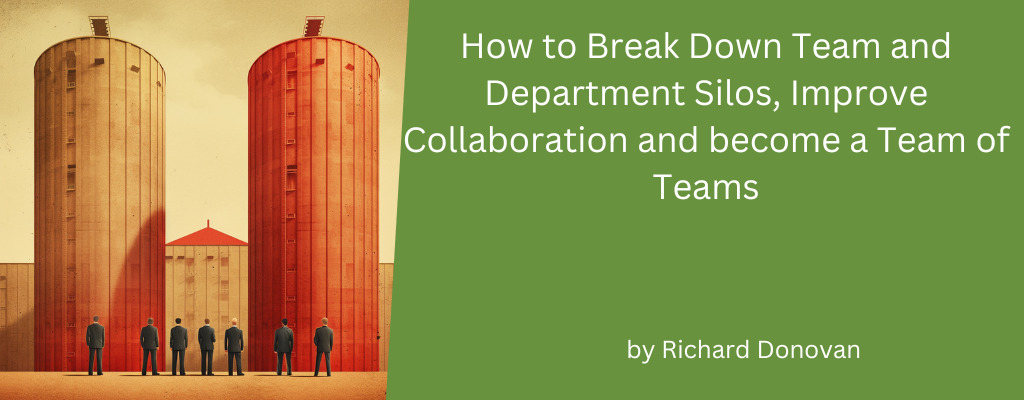
Agile • people development • team work • Work
How to Break Down Team and Department Silos, Improve Collaboration and become a Team of Teams
May 7, 2023
Introduction: Why do Large Companies Lose to Smaller Ones?
In many areas of business bigger is always better. As a result, large businesses should dominate however we keep seeing innovators and startups disrupting the large and existing companies. One of the main struggles of large companies is their ability innovate. This is due in large part to departments becoming siloed and rigid in their process, they are unable to communicate and collaborate effectively. If left unattended, the silo mentality can slow innovation, cause high performance employees to leave and create a negative effect on the overall success of the companies.
Table of Contents

Does Remote Work Make this Worse ?
The post-covid move to remote is still at early stages, and the research is ongoing. The early indications are that
- With remote/hybrid work teams have become more bonded, as they spend more time with each other online
- Cross team communication has declined as there is less opportunity for cross team pollination
Team silos
A silo is a walled team or department where the flow of communication is restricted. As much of our work is cross functional the silo mentality creates friction, poor communication, poor ability to plan accurately and general ineffectiveness. The department silo mentality can lead to power struggles. This produces substantial losses in resources, opportunities, and revenue.
The main reason organizational silos are quite hard to detect lies in their intangible nature. It’s only after concrete proof of poor performance that organizations can start to examine the silo mentality as one of the potential causes.
What causes the silo mentality?
The problem of silo mentality is further complicated by the fact that both communication and collaboration factor in here. Naturally, it causes twice the amount of issues to resolve when working to break down company silos.
In addition to withholding information, teams stuck in siloed thinking also tend to disregard the demands of the new, cross-functional mode of work. As the organizations grow, teams get more focused roles. Yet, most often, teams fail to adapt their processes to better meet the new collaboration needs. And this is especially evident over the last couple of years. As teams and entire organizations moved to a remote and hybrid environment, most struggled to overcome obstacles to successful collaboration.
While it can get pretty challenging to break down company silos, it’s a good practice to start from the root cause. To help you examine the issue more thoroughly, here are the most common factors causing the silo mentality at work:
Leadership discord : A disagreement between different team leaders on a plan or a strategy is one of the reasons organizational silos can happen. These power struggles often lead to a completely new set of communication and collaboration hurdles.
When the issue starts from the top of the organizational hierarchy, it quickly spreads to teams and individuals. Most often, this results in a significant productivity decrease, as the number one marker of larger structural issues.
Poor information-sharing Siloed behavior can result from a lack of incentives for information-sharing. Teams work in a closed environment with no encouragement to share information with affiliated departments. Over time, this generates a number of major productivity issues.
When departments don’t have a clear understanding of each others’ responsibilities and priorities, it can lead to duplicative work and mistrust, among other challenges. Moreover, miscommunication is largely present in organizations with multiple communication channels used by teams.
Unclear priorities Insufficient focus on larger priorities within organizations negatively impacts collaboration. This often breeds a silo mentality among teams. Without a clear, underlying vision to strive to, teams get focused on the narrower, department-specific goals.
Communication obstacles A lack of functional, flexible communication channels commonly creates team silos within organizations. As one of the key barriers to effective communication, poor communication tool options leave little room for effective sharing and collaboration. Organizations that rely solely on email to communicate between teams are missing important opportunities for building a healthier and more productive digital culture.
Lack of feedback opportunities Another major factor of siloed behavior is present in organizations that don’t prioritize and encourage feedback. A lack of trust and openness to share and solicit feedback across different departments often results in closed, siloed behavior, blocking collaboration.
Narrow expertise Organizations prioritizing specific, narrow expertise over a broader, cross-functional knowledge and organizational structure, often experience drawbacks of isolated team silos. Super-specific focus removes the larger perspective which is essential for cross-functional collaboration.
What are the challenges of isolation silos among departments? It is quite obvious that silos harm various structures and processes within an organization. In addition to the most apparent drawback of the silo mentality that reflects in the lack of efficiency, team silos most often disrupt the entire company culture.
5 Steps to Break Down Silos
We have a 5 step process to break down silos and create a collaborative culture of Team of Teams. These steps involved at a high level
- Gather Information
- Build a unified vision
- Plan the (incremental) change
- Create Change Events
- Analyze the Results
Gather Information
There is no simple solution, the first step is to gather the current as is status and feelings of conflict from all stakeholders. Important here is to include line workers who are doing their best to achieve their goals.
Build a unified vision
Silos happen when teams focus solely on their respective departments goals and team-specific goals. Very often, the goals of one team may clash with the objectives of another. This creates siloed environments resistant to information-sharing.
To move beyond this we have steps, practices and tools to build a more connected culture
A collaborative big picture vision – moving to collaborative won’t work if teams are still measured on old metrics.
We measure based on games won not balls kicked
A clear big picture vision inspires and shares to everyone the game we are playing and what a win looks like for everyone. From there we can set achievement goals
Achievement Goals are goals that teams can work together to achieve. They are not team or department specific. They align with KPIs and that is to complete projects or develop a new offering that is cross functional.
Plan the (incremental) Change
With a refined vision, goals and metrics we can start working with teams to take action. This involves:
- Identifying quick wins, areas of conflict that can be easily improved
- Identifying the biggest value wins, where we will gain the most time and financial gains
- Identifying the practices and tools that work best for the teams and organization
A key part of the transformation process is fostering good communication. This can involve
- Soft skills, regarding how to maintain respect at all times, everyone is trying to do their best with the information they have
- Also communication tools that allow
- You to quickly have the full understanding of the situation
- Quickly form the right cross functional teams to solve any problems
Update the company rituals
- Find space for fun, human interaction and company-wide discussions to humanize the company and strengthen employee engagement.
- Hold Team of Teams meetings these regular cross-department management meetings – to make sure all departments are up-to-date on each other’s responsibilities and priorities.
- Formalize a means to recognise and celebrate cross team collaboration
- cross-team training sessions and team-building events to improve communication awareness and trust, build empathy, and encourage interaction and sharing among all departments.
- Communication standards that build a more open and safe culture where teams are comfortable sharing and soliciting feedback and asking questions will result in better communication and cross-team collaboration. Communication champions can moderate aggressive siloed mentalities
- Create a safe space for feedback. Cross-teams can implement regular feedback sessions to reflect on the progress so far the journey to achieve yet.
- Provide knowledge sharing tools that allow information to be shared and not horded.
- Review employee satisfaction surveys and other feedback mechanisms to gauge progress
Serious Effort, Serious Gains
Breaking down silos and building teams of teams is a rewarding process that requires serious effort within an organization.
Asides from the productive and financial gains, a collaborative and respectful environment creates for a mentally healthier and more positive workspace able to deliver for the future challenges.
Richard Donovan is a CEO and consultant who has led both technical and agile transformations in many industries from Banking, Fintech, Logistics, Media and Telecoms.
Having worked with leading enterprises in his field Richard found that technology is often the smallest challenge and the team(s) and executive alignment and by far the hardest and most important challenges.
After decades of research goThink has evolved a visual and interactive workshop to discover the collative purpose, teach and ensure the adoption of the practices.


